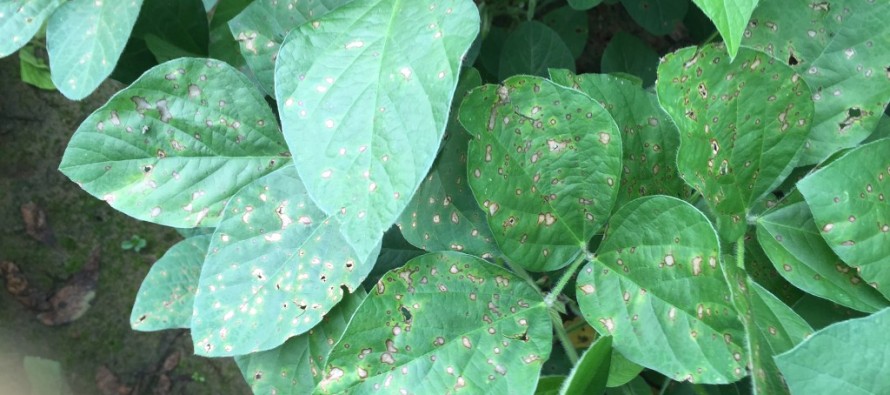Choose Fungicide Product for Soybean Fields Based on Variety Planted

Over the past several weeks we have received numerous telephone calls regarding fungicide product prices, performance in field trials, and what products may be suggested overall. First and foremost, before you decide on a particular fungicide product, you should be certain of which variety is planted in each field. Knowing the particular variety planted and the response of that variety to foliar disease can aid in the selection of a fungicide product for either an automatic fungicide application (R3/R4) or for disease management should a foliar disease arise. Using the information contained in the OVT ratings that were conducted during 2013 and 2014 look to see how particular varieties respond to frogeye leaf spot as well as Cercospora blight and in some limited situations Septoria brown spot. When considering the response of a particular variety to a disease such as frogeye leaf spot, look at more than the overall average of the variety across multiple locations. Consider how the variety performs at each of those locations and look at the range of responses since in some cases the environment at a particular location may reduce the potential of a disease such as frogeye leaf spot from occurring.
For the 2014 Maturity Group IV trials go to: https://www.mississippi-crops.com/2014/12/02/2014-soybean-variety-trial-disease-ratings-part-ii-maturity-group-iv-varieties/
For the 2014 Maturity Group V trials go to: https://www.mississippi-crops.com/2014/12/29/2014-soybean-variety-trial-disease-ratings-part-iii-maturity-group-v-varieties/
For the 2014 Conventional and LibertyLink trials go to: https://www.mississippi-crops.com/2014/11/25/2014-soybean-variety-trial-disease-ratings-part-i-conventional-and-libertylink-varieties/
To aid in fungicide selection, several characteristics are outlined below regarding the potential response of fungicide product application.
Strobilurin-resistant frogeye leaf spot
During 2013 and 2014 frogeye leaf spot infected leaf material was collected from fields throughout MS to complete a graduate student project funded by the MS Soybean Promotion Board. More than 630 leaf samples were collected from 73 total counties. The results of the laboratory screening trials determined that strobilurin-resistant frogeye leaf spot was present in at least one field in all 73 counties where the disease was detected. Moving forward, frogeye leaf spot observed on a frogeye leaf spot susceptible soybean variety should be assumed to be resistant to the strobilurin fungicides.
Since azoxystrobin is no longer on patent, several generic products containing azoxystrobin as the active ingredient are now available through multiple sources. All indications are that these particular products will be less costly than the normal, stand-alone strobilurin (QoI) based fungicides we have grown accustomed to applying (e.g., Aproach, Evito, Gem, Headline, Quadris). Caution should be taken when purchasing one of these products since application of a stand-alone strobilurin fungicide in a field of frogeye leaf spot susceptible soybean will ultimately provide zero benefit in managing the disease or benefiting yield. In addition, fungicides should be applied at the full label rate (e.g., for a Quadris application a 6 fl oz/a rate rather than a 4 fl oz/a rate), rather than applying a fungicide at a reduced rate since this can increase the likelihood of additional resistance developing within multiple fungal populations. A current list of the generic azoxystrobin-containing products can be obtained here (generic azoxystrobin products). In addition, more information on this situation can be accessed at:
Fungicide phytotoxicity
Trials conducted during 2013 and 2014 suggest that even though the application of some fungicide products may result in a phytotoxic response, see:
Based on numerous trials conducted over the past several years the application does not reduce yield. However, given that some commercially available products do produce a mild “burn” following the application be mindful of where those products were applied and keep close record of those fields. Several commercially available products can result in phytotoxicity (phytotoxicity producing fungicides). The particular response following application can occur based primarily on the environmental situation at the time of application (e.g., high humidity and high temperature). In addition, the response of fungicides results in a mild (e.g., Domark, Topguard), moderate (e.g., Stratego YLD), or severe phytotoxic response (e.g., Proline). However, as stated above, a yield reduction has not been observed following the application and resulting phytotoxicity.
New fungicide products
Over the past several months we have attempted to keep tally of the “new” fungicide products. More than likely, additional fungicide products will become available as we move forward this season. The list of products in the provided table includes products that are currently labeled for application to soybean in MS for a variety of diseases. However, keep in mind that on occasion some products are marketed as a “fungicide” even when they may not contain a synthetic fungicide active ingredient. Be mindful that most of these particular products have not been tested in a university setting and little if any data are available to suggest how they may perform in the field. Over the next year, multiple fungicide products will become commercially available that contain generic azoxystrobin as well as new combinations of multiple modes-of-action to be used to combat plant diseases in soybean production systems. In some cases, limited data are available on some of the products and soybean farmers should be aware that efficacy data in some cases are extremely limited. Always read and follow label instructions when applying any foliar fungicide. One important thing to note, Aframe and Aframe Plus offerings from Syngenta are the same as Quadris and Quilt Xcel, and simply combined the two labels of associated products (Abound and Quadris labels = Aframe). However, as near as we understand it, Aframe and Quadris will both be available during 2015. The new fungicide table is provided as a pdf (new soybean fungicides). In addition, Quadris Top is sold as both Quadris Top and Quadris Top SB; they are the same fungicide. However, a new offering from Syngenta, Quadris Top SBX contains the same active ingredients as Quadris Top, but has a 1:1 ratio of strobilurin:triazole.







Let me tell You a sad story ! There are no comments yet, but You can be first one to comment this article.
Write a comment